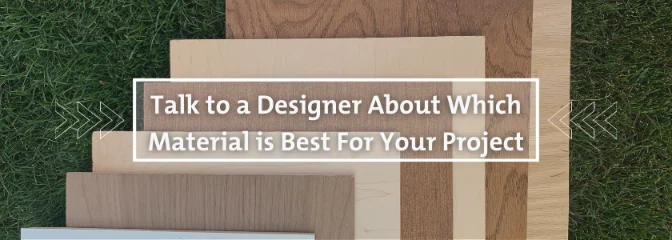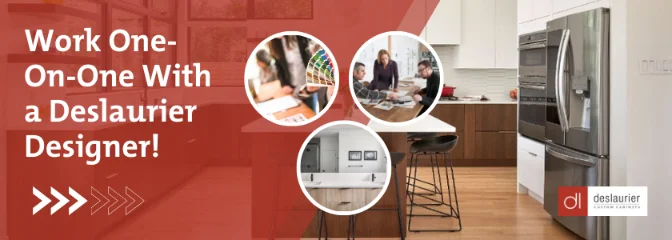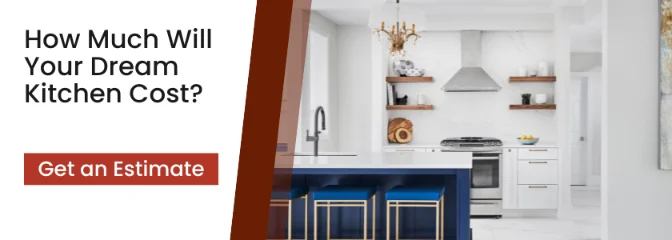11/01/2022 • Blog, Product Reviews
Melamine Cabinets: A Review of Kitchen Cabinets
Melamine cabinets have made leaps and bounds in recent decades.
For years, melamine was viewed as cheap or poor quality. Like the laminate countertop (those have changed, too) of the cabinet world, melamine has since developed into a popular option for kitchens.
Whether you’re doing a budget-friendly kitchen renovation or designing your dream kitchen, melamine offers options that fit any budget or design style.
At Deslaurier, we specialize in all things custom cabinetry, and offer a variety of melamine cabinet selections in our catalogue. Our clients often ask us about melamine cabinets and in this article we’ll give you the same answers we give them!
Let’s take a look at what melamine kitchen cabinets have to offer!
|
Table of Contents |
|
Cost Of Melamine Kitchen Cabinets Melamine Kitchen Cabinet Limitations |
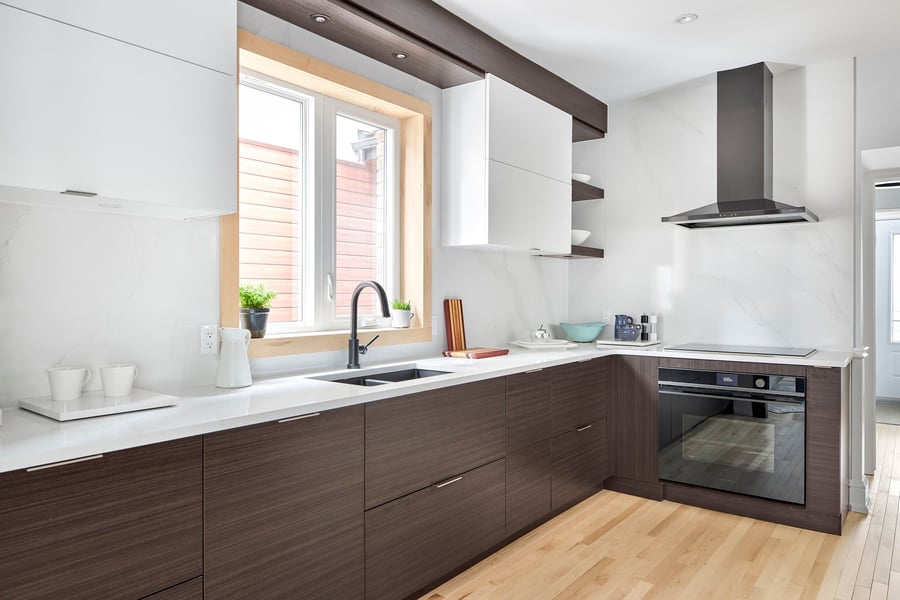
What Are Melamine Cabinets?
For starters, melamine no longer exists. It now goes by the name Thermally Fused Laminate (TFL), as opposed to what was formerly referred to as Thermally Fused Melamine (TFM).
Thermally Fused Laminate boards consist of a raw particleboard substrate with resin-infused decorative paper permanently fused to both sides. Heat and pressure activate the resin to effectively seal the substrate and produce cabinet doors.
For this article, we’ll refer to TFL as its universal colloquialism, melamine.
Melamine (TFL) boards are designed to reproduce the look and feel of realistic paint, wood grain, concrete, metals, or material designs. Melamine cabinet doors typically come in ⅝” or ¾” thicknesses.
Melamine Cabinet Styles
As previously mentioned, Melamine has come a long way in recent decades, and in more ways than one. No longer is it scoffed at as a subpar or “cheap” building material. The quality of melamine has increased exponentially in both its look and durability.
Modern melamines offer a quality and high-performance solution that meets the aesthetic demands of contemporary design with a simple, slab door style design.
Melamine cabinets are popularly used to replicate various wood grains but they also come in solid colours and are even capable of surface and texture decor matching. In fact, most manufacturers will carry hundreds of different melamine selections to choose from.
Let’s break down the look and feel of these different melamine options
Textured Melamine Cabinets
Textured melamine is the most common style of melamine cabinets. Textured melamine allows for the use of deep, congruent wood grain visuals in a man made product.
Since textured melamine are printed images, they can accurately replicate a vast amount of wood species’ grains or alternative surfaces. In fact, melamine will produce a more uniform, constant wood grain than a natural wood species. This is because hardwoods are natural materials, no two cabinets will have the exact same grain patterns. Melamine will.
Here are some textured melamine samples we offer at Deslaurier:
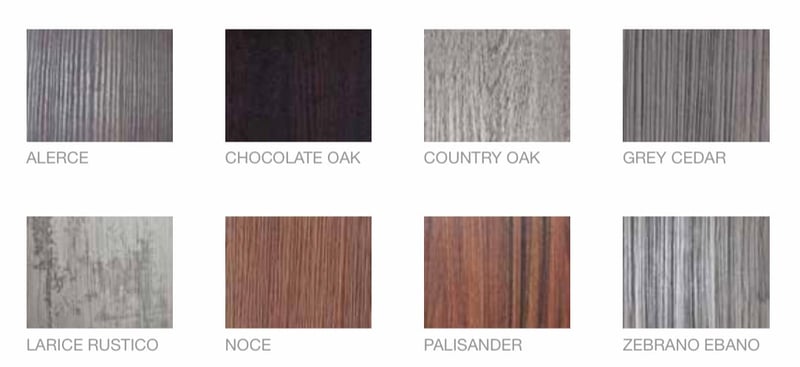
If you want real consistency in a wood grain look, textured melamine is the way to go.
When you stain natural wood, you’re getting a real tree with imperfections and incongruencies. A stain won’t always adhere consistently throughout the slab of wood and it can result in an uneven, or even sometimes blotchy, finish.
If you want to learn more about natural woods, check out our Learning Centre page for our article on Birch vs. Maple Cabinets.
These doors will look like wood, but they won’t be as convincing when you feel them. Since the decorative paper is sealed with plastic resins, the surface will have somewhat of a plasticky feel to it, depending on the quality of the product.
European Textured Melamine Cabinets
At Deslaurier, we offer standard textured melamine, as well as a premium, high-end product referred to as European Textured Melamine (ETM).
It’s known as European Textured Melamine because up until 2021, it was strictly sourced from Europe. Now, however, manufacturers are producing ETM in North America, and customers are reaping the benefits.
European textured melamine is considered a higher quality, luxury line of melamine. ETM produces a prestige material with deeper textures and colours, a more realistic-looking wood grain, and even feels more like natural hardwood.
Take a look at the depth and realism of these European Textured Melamine selections:
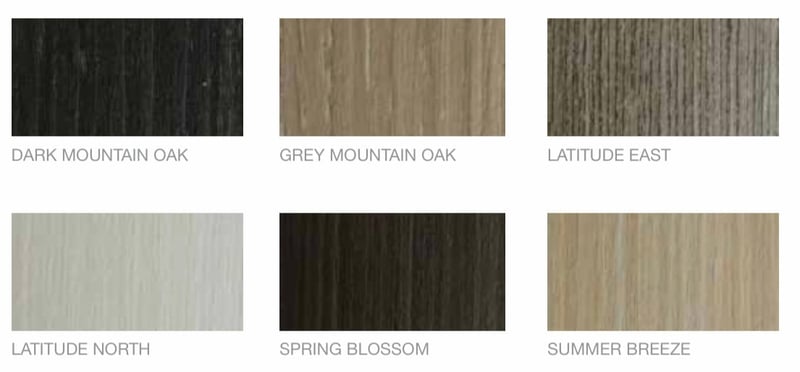
In contrast with standard textured melamine, ETM does not feel as “plasticky” and is a much more rich and convincing imitation of natural wood.
If you’re looking for a perfect, consistent hardwood aesthetic, European textured melamine is the highest quality option available on the market today.
Want to see how high-quality European textured melamine compares to natural wood cabinets? Check out our Learning Centre for Melamine vs. Natural Wood Cabinets!
Solid Colour Melamine Cabinets
Solid colour melamine is not nearly as popular as the wood grain variety but they do offer a nice alternative to traditional melamine wood grain aesthetics.
Solid melamine comes predominantly in a variety of blacks, greys, beiges, and whites. Some manufacturers will offer a small number of colourful options such as a deep blue or green, but traditionally, solid “colourful” melamine cabinet options (excluding whites and blacks) will be centralized around grey and beige tones.
Melamine Cabinet Quality
Melamine is one of the most durable cabinet materials on the market today, noted for its strong resistance to excessive moisture, heat, and stains.
Since the resin-filled paper is permanently fused to the particleboard substrate, melamine will not peel away. It also won’t delaminate like other fused products, such as thermofoil.
Although textured melamine and European textured melamine are quite similar to one another, ETM is a higher quality. It is thicker and holds up better to everyday bumps and damage.
While regular textured melamine is still a durable product, issues can arise. The corners, for example, can be prone to chipping.
Chips will result in the substrate becoming exposed. Depending on the size of the chip, this will leave the door looking flawed and the exposed particle board vulnerable to water damage that can spread throughout the material.
Speaking of water damage, thanks to the plastic coating, both types of melamine hold up well to liquid. If the doors get wet, be sure to properly dry them and there should be no issues.
That being said, the underlying substrate is extremely vulnerable to water damage. If the particleboard becomes exposed, from chips, scratches, or other damage, any liquid that finds its way within the substrate will spread like wildfire, even at the molecular level. So as long as the finish on the doors is not compromised, water should not be an issue.
As the TFL designation indicates, melamine is a laminate, which results in it being more “stable” than solid wood or wood veneer. What this means is that wood will naturally breathe (expand and contract) due to fluctuations in temperature or humidity. Even veneer will continue to move forever, simply because its wood finish over top of the substrate is a natural product. Melamine will not.
Melamine’s stability is one of the reasons why it is such a popular option for a uniform, consistent wood grain finish.
Cost of Melamine Kitchen Cabinets
When determining the cost of industry-wide products like kitchen cabinets, it’s important to understand that pricing will vary depending on the quality or grade of the material, market conditions, and manufacturer.
Standard melamine is significantly more cost-effective than premium selections like painted MDF or natural wood cabinets. For example, if a custom kitchen outfitted with maple cabinets were to cost $25,000, the same kitchen design in a faux maple grain melamine could come in roughly $7,000 to $12,000 cheaper.
That’s a stark contrast in pricing, and why melamine is worth consideration if your main preference is on the visual aesthetic of your cabinets. Melamine’s cost-effective pricing is one of the reasons why it is such a popular and budget-conscious choice for kitchen cabinets.
With regards to ETM, pricing is a lot steeper than standard melamine. European textured melamine is a premium, high-end product, and is priced accordingly. It is not uncommon for the price of ETM to rival that of painted MDF or a stained natural wood.
Limitations of Melamine Cabinets?
Melamine comes with a number of design limitations compared to other cabinet materials.
For starters, melamine will almost always come in a slab (flat) door style. Some manufacturers may offer 5-piece doors, but they are relatively few and far between, and the quality of the product is extremely lacking compared to MDF or natural wood 5-piece doors.
Since melamine is restricted to slab doors, everything else will be flat as well. Any decorative crown or trim moulding will be flat, with no opportunity to modify or customize the design.
There aren’t any detailed range hoods for melamine, either. Unlike a customizable natural wood like maple, melamine only offers slab cabinets in lieu of range hoods.
Picking a finish can also limit melamine cabinet designs. While there are plenty of solid colours, or deep, textured wood grains available, you’ll be limited to selecting only what is offered from the manufacturer.
That means, if you don’t like a certain colour or wood stain, there is no customizing it with a different shade or hue.
A natural wood stain has significantly more options than melamine. With wood, you can select a specific species and from there go as dark or as light as you want with a stain. Melamine, on the other hand, will only come with predetermined levels of stain, restricting the overall selection for wood grain cabinets.
So, while the consistency and variety of wood grains available in melamine are fruitful, the dearth of stains and colours can become restrictive the more particular you want to get.
How to Clean Melamine Cabinets
Another key characteristic of melamine is that it doesn’t require too much maintenance. All it needs is a quick wipe down for any dirt or slight stains and it will be fine. Since they come in slab doors, cleaning is as easy as it gets!
When using any water or liquid to clean, just ensure that you adequately dry the doors afterward. As you already know, water and moisture can spread like wildfire if it enters the particleboard substrate, so drying your cabinets immediately is a safe way to ensure no water damage can take place.
Cleaning and maintaining natural wood is a bit more of a hassle. Specifically, with 5-piece cabinet doors, cleaning joints and crannies can be an arduous task.
Lucky for you, we have something just for that! For a thorough, in-depth cleaning guide, check out our article on How to Clean Kitchen Cabinets.
Discover Deslaurier Custom Cabinets
Do you think melamine is the right choice for your kitchen cabinets? We’ve got you covered!
At Deslaurier Custom Cabinets, we offer high-quality textured melamine and European textured melamine cabinets.
If you have your eye on custom cabinetry, Deslaurier Custom Cabinets has everything you need. With over 40 years of experience to our name, we provide our clients with a wholly customized design process with our talented team of designers.
Book a free consultation today and meet with one of our Deslaurier design experts in our Ottawa showroom!


